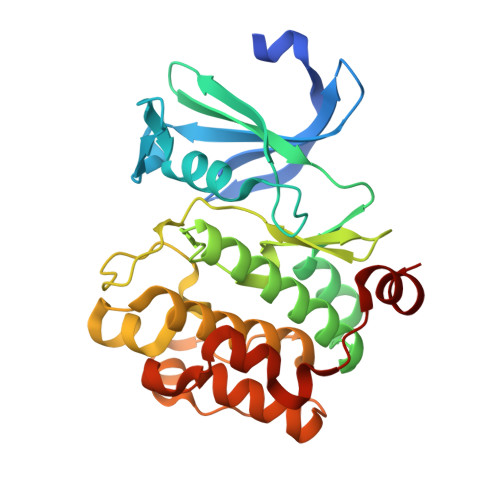Discovery and Optimization of Quinazolinone-pyrrolopyrrolones as Potent and Orally Bioavailable Pan-Pim Kinase Inhibitors.
Pettus, L.H., Andrews, K.L., Booker, S.K., Chen, J., Cee, V.J., Chavez, F., Chen, Y., Eastwood, H., Guerrero, N., Herberich, B., Hickman, D., Lanman, B.A., Laszlo, J., Lee, M.R., Lipford, J.R., Mattson, B., Mohr, C., Nguyen, Y., Norman, M.H., Powers, D., Reed, A.B., Rex, K., Sastri, C., Tamayo, N., Wang, P., Winston, J.T., Wu, B., Wu, T., Wurz, R.P., Xu, Y., Zhou, Y., Tasker, A.S., Wang, H.L.(2016) J Med Chem 59: 6407-6430
- PubMed: 27285051
- DOI: https://doi.org/10.1021/acs.jmedchem.6b00610
- Primary Citation of Related Structures:
5IPJ - PubMed Abstract:
The high expression of proviral insertion site of Moloney murine leukemia virus kinases (Pim-1, -2, and -3) in cancers, particularly the hematopoietic malignancies, is believed to play a role in promoting cell survival and proliferation while suppressing apoptosis. The three isoforms of Pim protein appear largely redundant in their oncogenic functions. Thus, a pan-Pim kinase inhibitor is highly desirable. However, cell active pan-Pim inhibitors have proven difficult to develop because Pim-2 has a low Km for ATP and therefore requires a very potent inhibitor to effectively block the kinase activity at cellular ATP concentrations. Herein, we report a series of quinazolinone-pyrrolopyrrolones as potent and selective pan-Pim inhibitors. In particular, compound 17 is orally efficacious in a mouse xenograft model (KMS-12 BM) of multiple myeloma, with 93% tumor growth inhibition at 50 mg/kg QD upon oral dosing.
- Department of Therapeutic Discovery-Medicinal Chemistry, ‡Molecular Structure, §Pharmacokinetics and Drug Metabolism, ∥Oncology Research, ⊥Pharmaceutics, #Discovery Technologies, Amgen Inc. , One Amgen Center Drive, Thousand Oaks, California 91320, United States.
Organizational Affiliation:


















